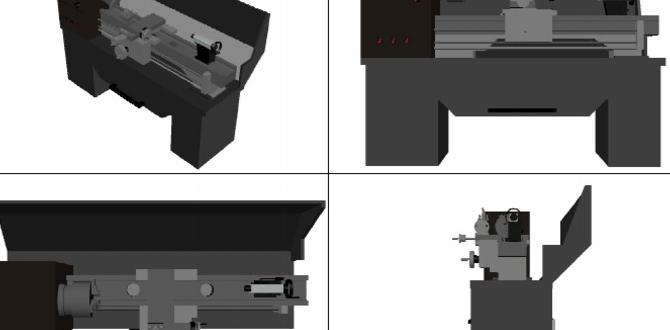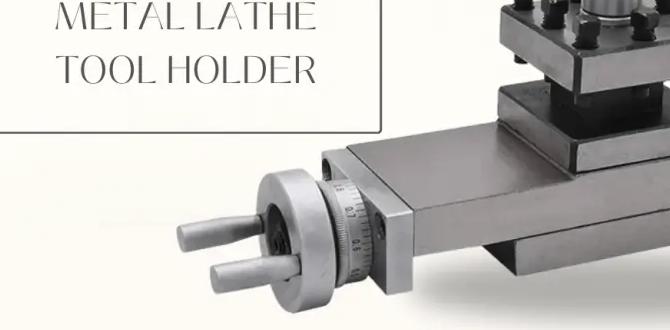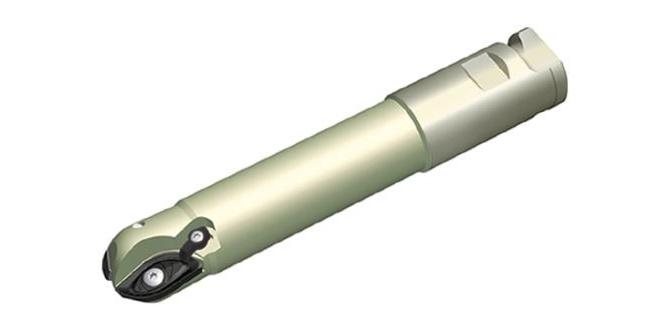Carbide end mills are crucial for precise dry cutting in metalworking, especially the 1/8 inch size. They offer excellent hardness and heat resistance for clean cuts on materials like aluminum without coolant, making them a go-to for hobbyists and professionals needing efficient, dry machining solutions.
Welcome to Lathe Hub! If you’ve ever stared at your milling machine, wondering about the best way to make a clean cut, you’re in the right place. We’re going to dive into something small but mighty: the 1/8 inch carbide end mill. It might seem tiny, but it’s a workhorse for detailed jobs, especially when you want to cut metal dry. Many beginners find it tricky to get clean results, leading to frustration. But don’t worry! We’ll break down exactly what you need to know about these end mills, how they work, and how to use them effectively. By the end of this guide, you’ll feel confident tackling your projects with this essential tool.
What is a 1/8 Inch Carbide End Mill and Why Use it Dry?
An end mill is a type of milling cutter, basically a specialized drill bit that can cut sideways as well as plunge straight down. Think of it like a router bit but for metal. The “carbide” part tells us what it’s made of: tungsten carbide. This material is incredibly hard and can withstand high temperatures, which is a big deal when cutting metal. A “1/8 inch” end mill refers to its cutting diameter – the width of the cutting edge. This small size is perfect for detailed work, engraving, or creating small slots and pockets.
Now, why “dry cut”? Usually, when machining metal, we use a coolant or cutting fluid. This fluid cools the tool and the workpiece, flushes away chips, and helps lubricate the cut. However, for certain materials and specific operations, dry cutting with a carbide end mill is not only possible but often preferred. Carbide’s ability to handle heat means it can often cut effectively without a flood of coolant. This simplifies your setup, reduces mess, and can be safer in certain environments or for specific applications. For materials like aluminum, a sharp carbide end mill can produce excellent surface finishes when cutting dry, especially with the right speeds and feeds.
The Benefits of Choosing Carbide for Dry Cutting
Carbide is the king of hardness in the cutting tool world. This superior hardness translates directly into several advantages when it comes to dry cutting:
- Heat Resistance: Carbide can handle much higher temperatures than High-Speed Steel (HSS). This is critical for dry cutting, where heat builds up quickly.
- Wear Resistance: Because it’s so hard, carbide wears down much slower than HSS. This means it stays sharp for longer, giving you more consistent cuts and a longer tool life.
- Rigidity: Carbide is more brittle than steel but also much stiffer. This rigidity helps prevent chatter and vibration, leading to cleaner finishes and more accurate cuts, especially with small diameter tools like a 1/8 inch end mill.
- Higher Cutting Speeds: Due to its heat and wear resistance, you can often run carbide tools at higher surface speeds (feet per minute) than HSS, potentially speeding up your machining operations.
When we specifically talk about a “carbide end mill 1/8 inch 10mm shank extra long for aluminum 6061 dry cutting,” we’re getting very specific. This describes a tool perfect for hobbyists and professionals working with aluminum. The 10mm shank provides a good grip in many common milling machine collets or holders. The “extra long” feature is key for reaching into deeper pockets or cutting features that are further from the workpiece surface. And targeting aluminum 6061, a very popular and machinable alloy, with dry cutting capabilities means this tool is optimized for a common scenario.
Understanding Key Terms for Your 1/8 Inch Carbide End Mill
Before we get too deep, let’s clarify some terms you’ll encounter when choosing and using your end mill. Think of this as your quick glossary for success:
- Diameter: This is the cutting width of the end mill. For our topic, it’s 1/8 inch (or about 3.175 mm).
- Shank Diameter: This is the diameter of the part of the end mill that goes into your machine’s collet or holder. A 10mm shank is common for many desktop milling machines and some larger ones.
- Flutes: These are the helical grooves that run along the cutting part of the end mill. They carry chips away from the cutting edge. More flutes generally mean a smoother finish but less chip clearance. For dry cutting aluminum, 2-flute or 3-flute end mills are often recommended.
- Length of Cut (LOC): This is how far down the flutes extend from the shank. An “extra long” end mill will have a longer LOC, allowing you to cut deeper features.
- Overall Length: The total length of the end mill from the tip to the end of the shank.
- Coating: Some carbide end mills have special coatings (like TiN, TiCN, AlTiN) to improve performance, reduce friction, and extend tool life. For dry cutting aluminum, a bright finish (uncoated) or a coating designed for non-ferrous materials might be best.
- Material: We’re focusing on carbide, but it’s good to know HSS (High-Speed Steel) and Cobalt are other common materials.
- Helix Angle: This is the angle of the flutes. A steeper helix angle can help pull chips away faster.
Types of 1/8 Inch Carbide End Mills and Their Uses
Not all 1/8 inch carbide end mills are created equal. The design of the end mill greatly influences its performance. Here are a few common types you might encounter:
| End Mill Type | Description | Best For (Dry Cutting Aluminum) |
|---|---|---|
| Flat End Mill | Has a flat tip, allowing it to create square shoulders and flat-bottomed pockets. The most versatile type. | General purpose milling, slotting, pocketing, profiling. Excellent for creating 90-degree corners. |
| Ball Nose End Mill | Has a rounded tip, creating a radius at the bottom of the cut. | 3D contouring, creating radiused corners, sculpturing, creating fillets. |
| Corner Radius End Mill (or Bull Nose) | Similar to a flat end mill but with a small radius at the cutting corners. | Provides a slight radius in corners to reduce stress concentration and improve finish over a sharp corner. Good for profiling and pocketing where sharp corners aren’t critical. |
| Engraving End Mill | Usually has a very small diameter (often with a ball nose) and a shallow flute design. May have a steeper tip angle. | Light duty engraving, marking, or very fine detail work. Not suitable for heavy material removal. |
For general-purpose dry cutting of aluminum 6061 with a 1/8 inch carbide end mill, a two-flute or three-flute flat end mill is usually the best starting point. The 1/8 inch size is great for detailed work, but remember that smaller tools require specific handling and parameters.
Choosing the Right 1/8 Inch Carbide End Mill for Aluminum
When you’re ready to buy, keep these factors in mind, especially if your goal is “carbide end mill 1/8 inch 10mm shank extra long for aluminum 6061 dry cutting”:
- Flute Count: For aluminum, especially for dry cutting, 2 or 3 flutes are generally ideal.
- 2-Flute: Offers excellent chip clearance, which is crucial for preventing chip recutting and overheating in aluminum. This is often the top choice for softer materials like aluminum.
- 3-Flute: Can provide a smoother finish and allow for slightly higher feed rates than a 2-flute due to more cutting edges, but chip clearance is reduced. May require slightly more careful speed and feed selection to avoid chip packing.
- Material and Coating: For aluminum, an uncoated carbide end mill often performs very well. Sometimes, specific coatings like ZrN (Zirconium Nitride) can offer a low-friction surface that helps prevent aluminum from sticking (welding) to the cutting edge, improving finish and tool life. Avoid AITiN or TiAlN coatings for aluminum as they are designed for higher-temperature steel machining and can sometimes cause aluminum to adhere more readily.
- Shank Size: Ensure the shank diameter matches your machine’s collet system (e.g., 10mm for many hobby machines). A secure fit is vital.
- Length: If your project requires deep cuts or reaching into confined spaces, choose an “extra long” shank and/or length of cut. Be mindful that longer tools are more prone to vibration and deflection, so you might need to reduce cutting forces (e.g., slower feed rates, shallower depths of cut).
- Quality: Invest in a reputable brand. A well-made end mill, even a small one, will perform far better and last much longer than a cheap, poorly manufactured tool.
Where to Find Quality Tools
You can find excellent 1/8 inch carbide end mills from dedicated tooling manufacturers and suppliers. Look for brands known for quality in the machining world. Online retailers specializing in CNC tools and machining supplies are great resources. For example, companies like PreciseBits, Lakeshore Carbide, or even reputable brands on platforms like Amazon (with careful seller vetting) can be good places to start. Always check reviews and product specifications carefully.
A great resource for understanding machining tool standards and recommendations is the Machine Tool Research website, which often provides in-depth analysis and comparisons of tools and techniques.
Setting Up Your Machine for Dry Cutting
Dry cutting with a 1/8 inch carbide end mill doesn’t require coolant systems, which simplifies things greatly. However, proper setup is still key for safety and performance.
Essential Machine Checks Before You Start
Before you even think about cutting, do a quick check of your machine:
- Spindle Runout: Ensure your spindle is running true. Excessive runout will cause the end mill to wobble, leading to poor finish, broken tools, and inaccurate cuts. With small diameter tools like a 1/8 inch end mill, even a little runout can be catastrophic.
- Collet and Holder Cleanliness: Make sure your collet and the machine’s spindle taper are perfectly clean and free of debris. Any tiny chip or dirt can cause the end mill to run eccentrically.
- Tool Holding Rigidity: A long, thin end mill held in a worn or loose collet is a recipe for disaster. Ensure your collet nut is properly tightened and the collet is in good condition.
- Workpiece Clamping: Your workpiece must be held extremely securely. Any movement during cutting will ruin the part and can be dangerous. For small parts, use appropriate vices, clamps, or fixturing.
Chip Evacuation Strategy
Even though you’re not using coolant, getting the chips away from the cutting area is paramount for dry cutting. If chips build up, they clog the flutes, overheat the tool, and can cause the tool to break or the aluminum to re-weld itself to the cutting edge.
- Air Blast: A constant stream of compressed air directed at the cutting zone is the most common method for dry cutting. This blows chips away and provides some minor cooling effect.
- Chip Ejector Nozzles: Some machines have specialized nozzles that direct air precisely where needed.
- Intermittent Cutting: Sometimes, especially with deeper cuts or less efficient chip evacuation, you might need to retract the tool periodically to clear chips.
- Optimize Speeds and Feeds: Proper speeds and feeds help create smaller, more manageable chips that are easier to evacuate.
Speeds and Feeds for 1/8 Inch Carbide End Mills in Aluminum
This is where many beginners get stuck. Finding the right “speeds and feeds” is critical for success with any machining operation, especially with small tools and dry cutting.
Speeds and feeds refer to how fast the tool spins (spindle speed, RPM) and how fast it moves into the material (feed rate, inches per minute or mm per minute). For aluminum, you generally want higher spindle speeds and relatively fast feed rates compared to steel.
Why is this important for dry cutting 1/8 inch end mills?
- High RPM: Allows the cutting edges to pass through the material quickly, generating heat that some of the carbide can dissipate.
- Adequate Feed Rate: A fast enough feed rate ensures that each cutting edge takes a proper chip. If the feed rate is too slow, the cutting edge rubs rather than cuts, leading to excessive heat and rapid tool wear. For a 1/8 inch end mill, this means taking a chip that is thick enough to be effective.
- Cooling Through Air: The rapid movement of the tool through the air also helps to move heat away.
General Guidelines for Aluminum 6061 (Dry Cut, Carbide)
These numbers are starting points. Always consult your end mill manufacturer’s recommendations if available. You’ll often find manufacturer charts that list Golden Numbers for speeds and feeds. Online calculators are also very helpful.
Let’s break down the calculation process:
- Surface Speed (SFM or SMM): This is the speed at which the cutting edge of the tool moves. For carbide in aluminum, a good starting point for Surface Speed is around 300-600 SFM (Surface Feet per Minute). Let’s use 450 SFM as an example.
- Calculate Spindle Speed (RPM):Formula: RPM = (Surface Speed 3.82) / DiameterUsing our example: Diameter = 1/8 inch = 0.125 inches
RPM = (450 SFM 3.82) / 0.125 inches
RPM = 1719 / 0.125
RPM = 13,752 RPM
This is a high RPM, which is common for small end mills in aluminum. Many hobbyist machines might not reach this, so you’ll use the maximum RPM available and adjust feed rate accordingly.
- Chip Load (CL): This is the thickness of the material each cutting edge removes per revolution. For a 1/8 inch 2-flute carbide end mill in aluminum, a good starting chip load is around 0.001 – 0.002 inches per tooth. Let’s use 0.0015 inches per tooth.
- Calculate Feed Rate (IPM or MMPM):Formula: Feed Rate = Chip Load Number of Flutes RPMUsing our example: Chip Load = 0.0015 inches/tooth, Flutes = 2, RPM = 13,752
Feed Rate = 0.0015 2 13,752
Feed Rate = 41.25 Inches Per Minute (IPM)
IMPORTANT CONSIDERATIONS:
- Machine Capability: Hobby machines might struggle to achieve 13,000+ RPM. If your max RPM is, say, 5000, you’ll need to recalculate your feed rate based on that lower RPM. The chip load will likely need to be reduced slightly too, or you run the risk of overloading the tool.
- Depth of Cut (DOC) and Width of Cut (WOC): These are also crucial. With small end mills, you generally can’t take very deep or very wide cuts.
- Depth of Cut (DOC): Start shallow! For a 1/8 inch end mill, a DOC of 0.050″ to 0.100″ is often a good starting point. You can take more aggressive cuts if your machine is rigid and you’re not experiencing chatter.
- Width of Cut (WOC): For full slotting (WOC = 1/8 inch), you might need to reduce feed rate and depth of cut. For profiling or pocketing where WOC is less than the tool diameter (e.g., 0.050″), you can often use higher feed rates and depths.
- “High Feed” Milling Strategies: For aluminum, sometimes using a shallower






